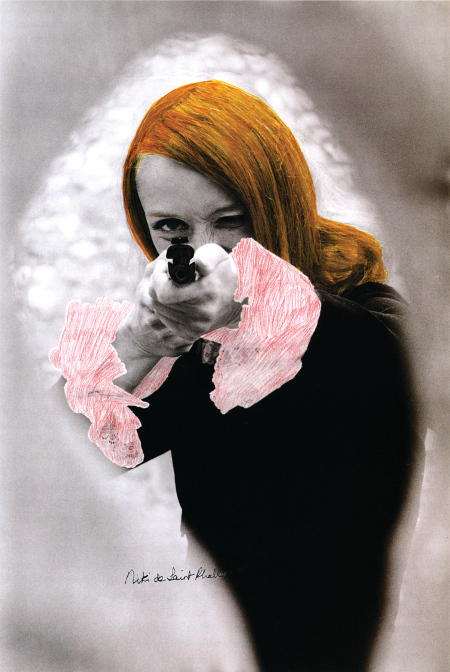Madeleine Morley uncovers the Guggenheim Bilbao’s retrospective of French artist Niki de Saint Phalle, whose colourful and exuberant work celebrates the diversity of the female form and battled an oppressive patriarchy
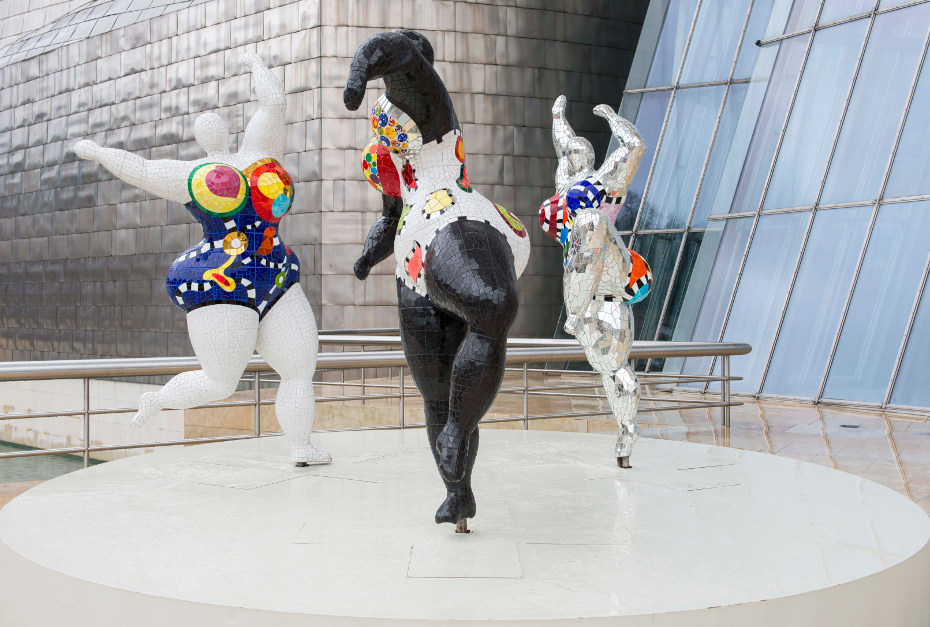
The estate of the French painter and sculptor Niki de Saint Phalle, led by her granddaughter Bloum Condominas, have wanted to put on a major retrospective of her work for years, especially since her death in 2002. For various reasons, it’s never happened, so any current perception of de Saint Phalle – a prolific, extremely diverse artist – has tended to rely on her famed, exuberant “earth mother” Nanas sculptures. Think of these as her hits – the glossy pop-songs that are remembered while less immediately catchy songs gather dust.
“This exhibition is a re-discovery of her work – the things you might think of her aren’t necessarily true, and the retrospective will show you that” says Camille Morineau, the co-curator of the comprehensive exhibition that is at last happening, at the Guggenheim in Bilbao, Spain. “We need a younger generation talking and writing about Niki,” adds granddaughter Bloum, who has worked closely with curators Camille and Alvaro Rodrigues Fominaya to make this show happen. “We need people to explore her from a young perspective, so people can see how contemporary her work is.”
Niki’s colourfully monumental art deals, in part, with being a woman in the excessively body-conscious world of the 50s and 60s. Powerfully interested in women’s roles, her approach, attitude and strength should make her an artist that is widely discussed today.
Bilbao’s Guggenheim is the perfect place to showcase de Saint Phalle’s work in its entirety, from the Nanas she gave birth to, as well as her other, darker and less familiar projects. The space looks different depending on where you stand, like the artist herself, always confounding expectations. De Saint Phalle was many different women, not just the bohemian mother of the Nanas she is so often remembered by.She was Niki the teenage model, the angry woman, the loving housewife, the abused daughter, the inspiring collaborator, the blushing bride, the grandmother, the femme fatale, the swaggering hero, the avant-garde feminist, the celebrity on Andy Warhol’s arm, the self-taught, radical artist; this show reveals how these various selves infused her art. The exhibition’s structure is chronological, spanning six constantly changing decades. There are around 200 works included, beginning at the very start of her career as a model in the late 40s and early 50s for Vogue and Life magazines. Throughout the Guggenheim’s spiralling rooms, we see how her art was in dialogue with the process and progress of her life.
Having married young, she had a child and lived a typically well-off American lifestyle, before suffering a nervous breakdown in 1953. De Saint Phalle was institutionalised and treated with shock therapy like her equally unclassifiable but determined predecessors Sylvia Plath and Zelda Fitzgerald. They too were frustrated by the world of domesticity and its suffocating effect on any form of individual creative expression. Due to the strain on their mental health, they were all ultimately labelled ‘hysterical women’. Bloum tells me about how de Saint Phalle’s therapist said she should ‘blame herself’ for the sexual abuse she’d experienced from her father as a child: it is this kind of offensive patriarchy that de Saint Phalle battled against, both personally and creatively.
“Think of these as her hits – the glossy pop-songs that are remembered while less immediately catchy songs gather dust”
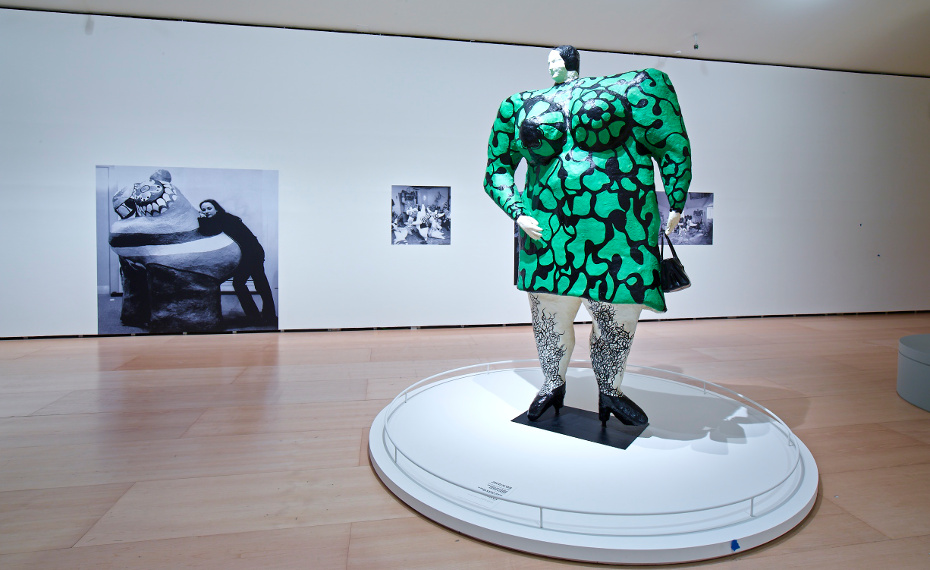
She embraced art as therapy and then decided on art as a career, before moving to Spain for inspiration. Her early work shows a woman trying to re-arrange the restrictive world around her into a new narrative. Fragments of domesticity like coffee beans, pottery, dolls and toy soldiers became the homespun medium of her collages. These materials of girlhood and motherhood were reconfigured into new shapes and images as she decided to break out of the traditional female role.
For the retrospective, Camille, Alvaro and Bloum have positioned de Saint Phalle very much as one of the first major feminist artist of the 20th century. They use these first, liberating pieces so that we see her later, less obviously volatile garden decorations and Nanas in the context of protest and resistance.
In the 60s, Niki was working on her early, explosive Shooting Paintings. They were dramatic performances, where she shot at pristine white plaster casts, the white of lace, so that they’d burst with colour when paint dripped from the bullet holes; these were more explicitly about her response to a nasty, repressive world. She was the first to use guns in art in this way, and it was as if she was releasing her thoughts and inner turmoil through the destructive act. De Saint Phalle once said: “I was shooting at myself – I was shooting at my own violence and the violence of the time.”

“The jubilant sculptures have been described as goddesses, as witches, as grandmothers, as shrines – they’re women who are uncorseted, confident, voluptuous and free”
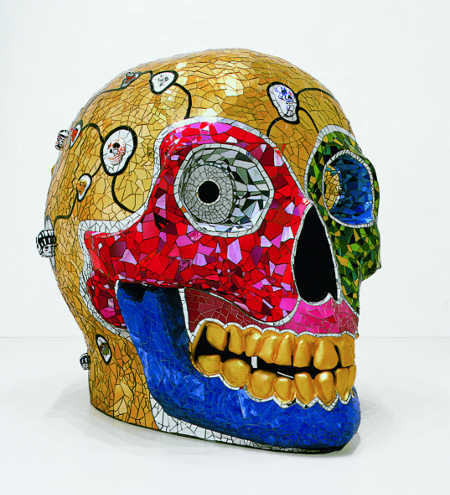
“I’m not a person who can change society but I can present a vision. That’s all that I can do” – Niki de Saint Phalle
As the work burst from white plaster into colour, it revealed that de Saint Phalle was a subversive: she too burst with force and spontaneity although she appeared to be just a pretty model on the outside. “It’s easy to forget how dangerous this act was in the 60s,” says Camille. “This would have completely shocked people at the time.”
The slashes of colour erupting from her Shooting Paintings anticipate the gaudy colours of the Nanas sculptures. Instead of letting emotion – the wounds of life – drip out of the work as with the early Shooting Paintings, the Nanas boldly display emotion and colour on the outside. “She was missing heroines and role models as a kid,” Bloum explains, “so she decided to make some herself.” The jubilant sculptures have been described as goddesses, as witches, as grandmothers, as shrines – they’re women who are uncorseted, confident, voluptuous and free.
“I’m not a person who can change society but I can present a vision. That’s all that I can do,” de Saint Phalle says in a video projected over her creations on display. Although easily dismissed as relics of the hippie 60s and 70s, the voluminous sculptures still pack a modern punch and hint to potential future possibilities, ones that seem equally relevant for women today. The Nanas seem to have been guardian angels for de Saint Phalle. In the same room where they are displayed at the Guggenheim Bilbao, prints of diary-like drawings and love notes reveal a very self-conscious woman, obsessed with diet pills and sexy stockings. The nearby Nanas are perhaps totems from a world where people aren’t disturbed by these anxieties, and her way of creating images and rituals is an antidote to their corrupting influence.
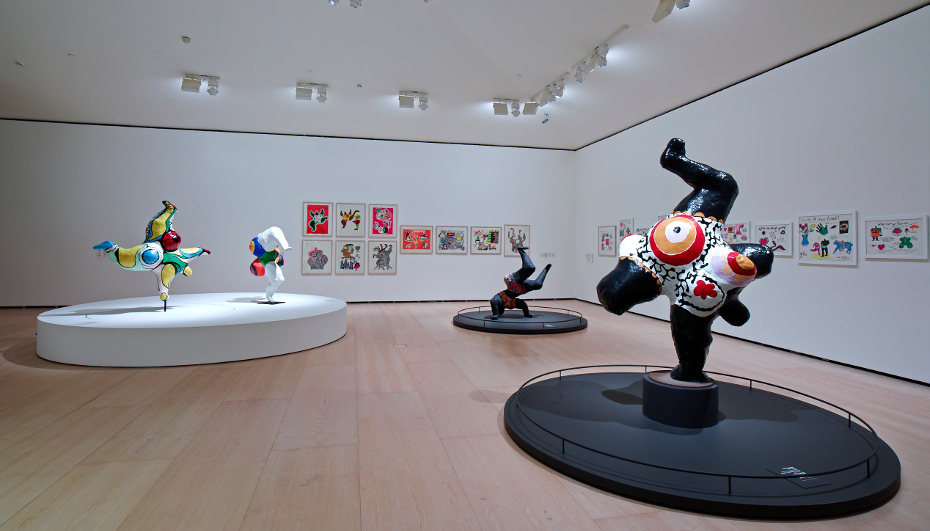
Niki the person was magnetic but anxious and temperamental; the artist was in control of her life and used art as a restorative guiding spirit. Her 70s Devouring Mothers sculptures and her film, Daddy, are works that turn to her interior life and they jar with the sheer joyfulness of the Nanas. They’re darkly humorous pieces that she used as a way to come to terms with her difficult childhood, which the Nanas were unable to protect her from. At the end of the 70s, de Saint Phalle also married fellow artist Jean Tinguely – a tumultuous though inspirational relationship that fed into her angst as well as her artistic inventiveness. The couple self-fashioned themselves as the Bonnie and Clyde of the art world and the relationship had a striking influence on her work – she influenced him and he influenced her.
Because this exhibition brilliantly captures an entire life in action, we also see de Saint Phalle as a kind of grandmother figure to all children. We see her designs for parks and playgrounds where she extends her vision of joy to public spaces, imagining a world designed not in mundane blocks but as outbursts of whimsy and intrigue. Outside the museum, on the Guggenheim balcony, three of her Nanas dance deliriously in the Bilbao sun, glimmering like the shiny surface of the immense structure. They’ve found a real home.
Frank Gehry, the Guggenheim Bilbao’s architect, and de Saint Phalle were apparently going to collaborate on a building together, but it never went ahead – a world designed by minds like these would be extraordinary. This show positions de Saint Phalle as an artist with stunning vision, one that challenges the ordinary and shows how fantasy can be a very necessary and practical part of reality. She was always growing, her colours getting richer, her shapes more dramatic, and in light of the full body of her work, she keeps growing.
